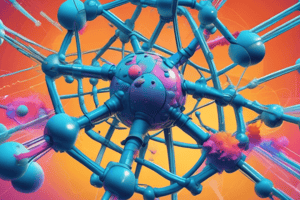Podcast
Questions and Answers
What are the three main particles that make up an atom's nucleus?
What are the three main particles that make up an atom's nucleus?
- Protons, neutrons, and photons
- Protons, neutrons, and neutrinos
- Protons, neutrons, and positrons
- Protons, neutrons, and electrons (correct)
What is the term for a form of an element's atom with the same number of protons but a different number of neutrons?
What is the term for a form of an element's atom with the same number of protons but a different number of neutrons?
Isotope
Radioactive decay is a random process in which one cannot know what nucleus will decay or when it will decay.
Radioactive decay is a random process in which one cannot know what nucleus will decay or when it will decay.
True (A)
Which of the following is NOT a process of radioactive decay?
Which of the following is NOT a process of radioactive decay?
Alpha decay occurs when a heavy nucleus emits an ______ particle.
Alpha decay occurs when a heavy nucleus emits an ______ particle.
What type of particle is emitted during beta decay?
What type of particle is emitted during beta decay?
What is the name given to weak radiation that can be detected from external sources?
What is the name given to weak radiation that can be detected from external sources?
What is the unit of measurement for the activity of a radioactive source?
What is the unit of measurement for the activity of a radioactive source?
What is the time taken for half the nuclei in a radioactive sample to decay, or for the activity of the sample to halve?
What is the time taken for half the nuclei in a radioactive sample to decay, or for the activity of the sample to halve?
Which of the following is NOT a use of radioactivity?
Which of the following is NOT a use of radioactivity?
Contamination occurs when a radioactive source has been introduced into or onto an object, making it radioactive.
Contamination occurs when a radioactive source has been introduced into or onto an object, making it radioactive.
What is the process of splitting a nucleus called?
What is the process of splitting a nucleus called?
What is the main purpose of control rods in a nuclear reactor?
What is the main purpose of control rods in a nuclear reactor?
What is the process of fusing two nuclei to form a larger nucleus called?
What is the process of fusing two nuclei to form a larger nucleus called?
Nuclear fusion occurs at low temperatures and pressures because the electrostatic repulsion of the protons is too great.
Nuclear fusion occurs at low temperatures and pressures because the electrostatic repulsion of the protons is too great.
Flashcards
Atom Structure
Atom Structure
An atom consists of a nucleus with protons and neutrons, surrounded by electrons.
Proton
Proton
A positively charged particle in the nucleus with a relative mass of 1.
Neutron
Neutron
A neutral particle in the nucleus with a relative mass of 1.
Electron
Electron
Signup and view all the flashcards
Isotope
Isotope
Signup and view all the flashcards
Radioactive Decay
Radioactive Decay
Signup and view all the flashcards
Alpha Decay
Alpha Decay
Signup and view all the flashcards
Beta Decay
Beta Decay
Signup and view all the flashcards
Gamma Decay
Gamma Decay
Signup and view all the flashcards
Neutron Radiation
Neutron Radiation
Signup and view all the flashcards
Geiger-Muller Tube
Geiger-Muller Tube
Signup and view all the flashcards
Background Radiation
Background Radiation
Signup and view all the flashcards
Activity
Activity
Signup and view all the flashcards
Half-life
Half-life
Signup and view all the flashcards
Smoke Detectors
Smoke Detectors
Signup and view all the flashcards
Nuclear Fission
Nuclear Fission
Signup and view all the flashcards
Control Rods
Control Rods
Signup and view all the flashcards
Nuclear Fusion
Nuclear Fusion
Signup and view all the flashcards
Radiation Shielding
Radiation Shielding
Signup and view all the flashcards
Contamination
Contamination
Signup and view all the flashcards
Irradiation
Irradiation
Signup and view all the flashcards
DNA Damage
DNA Damage
Signup and view all the flashcards
Safety Measures
Safety Measures
Signup and view all the flashcards
Gamma Emitters in Medicine
Gamma Emitters in Medicine
Signup and view all the flashcards
Fallout
Fallout
Signup and view all the flashcards
Ecological Effects of Radiation
Ecological Effects of Radiation
Signup and view all the flashcards
Nuclear Reactor Core
Nuclear Reactor Core
Signup and view all the flashcards
Cosmic Rays
Cosmic Rays
Signup and view all the flashcards
Medical Radiation Sources
Medical Radiation Sources
Signup and view all the flashcards
Study Notes
Radioactivity and Particles
- Atom Structure: Atoms consist of a positively charged nucleus containing protons and neutrons, surrounded by negatively charged electrons.
- Nucleus: The nucleus contains almost all the atom's mass. The radius of the nucleus is much smaller than the atom's overall radius.
- Particle Properties:
- Protons: Relative mass 1, Relative charge +1
- Neutrons: Relative mass 1, Relative charge 0
- Electrons: Relative mass 0.0005, Relative charge -1
- Isotopes: Atoms of the same element can have different numbers of neutrons, these are called isotopes.
- Radioactive Decay: Unstable nuclei undergo spontaneous transformation into a more stable nucleus by releasing radiation. This process is random and unpredictable.
- Decay Processes:
- Alpha Decay: A heavy nucleus emits an alpha particle (helium nucleus - 2 protons and 2 neutrons). These are highly ionizing and weakly penetrating, stopped by paper or a thin sheet of metal.
- Beta Decay: The nucleus changes by converting a neutron into a proton and an electron (beta particle). This changes the atomic number and creates a different element. They are moderately ionizing and moderately penetrating, stopped by thin sheets of aluminum.
- Gamma Radiation: A nucleus with excess energy emits a gamma ray. They are a form of electromagnetic radiation, are lowly ionizing, and highly penetrating, requiring several centimeters of lead for stopping.
- Neutron Emission: In neutron rich nuclides, neutrons can be emitted.
- Detecting Radiation: Methods include photographic film badges, Geiger-Müller tubes.
- Background Radiation: Weak radiation from external sources.
- Sources of Background Radiation: Cosmic rays, radioactive rocks, food and drink (containing isotopes), industrial fallout, medical sources (X-rays, MRI), nuclear power.
- Activity: The number of decays per unit time, measured in becquerels (Bq).
- Half-Life: The time taken for half of the nuclei in a sample to decay (or for the activity to halve). A constant for a given isotope, independent of starting amount.
- Uses of Radioactivity:
- Medicine: Sterilization of equipment, diagnosis and treatment using tracers (short half-life gamma emitters), destroying tumors (high dose gamma emitters)
- Industry: Thickness monitoring of materials using beta radiation, smoke detectors (using alpha radiation).
- Contamination vs. Irradiation: Contamination is when a radioactive source is on or in an item, making it radioactive. Irradiation occurs when an item is near or exposed to a radioactive source, but the source isn't on/in the item therefore the object remains non-radioactive.
- Safety Measures: Minimizing exposure time, maximizing distance, using shielding.
Fission and Fusion
- Nuclear Fission: The splitting of a heavy nucleus (like Uranium-235) into lighter nuclei. This releases a large amount of energy. Used in nuclear power plants and weapons.
- Fission Process: The process often starts by a neutron hitting the nucleus, which splits into two or more fragments and releases further neutrons, causing further reactions and a chain reaction of splitting. Control rods and moderators are used to control the speed and number of these splits and to prevent the reactor from melting down.
- Nuclear Fusion: Combining light nuclei (like hydrogen) into a heavier nucleus. Also releasing a large amount of energy.
- Fusion Process: This process needs extremely high temperatures and pressures to overcome electrostatic repulsion between protons and occurs in stars, rather than being currently utilized on earth in a controlled manner.
Studying That Suits You
Use AI to generate personalized quizzes and flashcards to suit your learning preferences.





